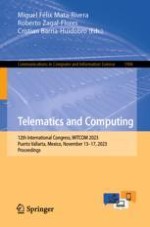2023 | Buch
Telematics and Computing
12th International Congress, WITCOM 2023, Puerto Vallarta, Mexico, November 13–17, 2023, Proceedings
herausgegeben von: Miguel Félix Mata-Rivera, Roberto Zagal-Flores, Cristian Barria-Huidobro
Verlag: Springer Nature Switzerland
Buchreihe : Communications in Computer and Information Science
